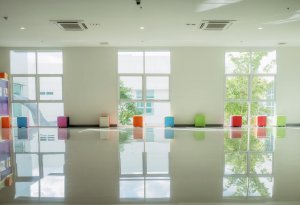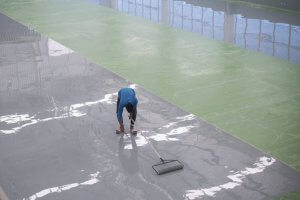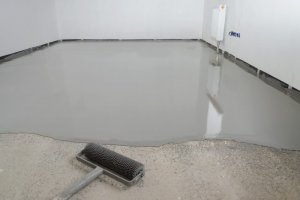How to Use Epoxy Paint in Your Decor

Heard about epoxy paint and want to use it in your home? In this article, we’ll tell you everything you need to know about this fantastic paint and show you how you can use it for your flooring, whether interior or exterior.
Epoxy paint gives floors a hard, smooth surface that makes them super easy to clean, and transforms them into the star feature in any home.
What is epoxy paint?

First, you need to know what exactly we mean when we say epoxy paint. Its main advantage is that it allows you to give your floors a semi-gloss finish, which reduces dust and dirt, without making the surface slippery.
Epoxy paint is used for both interior and exterior flooring. It is highly resistant to water, oil, erosion and even gasoline. As a result, it’s often used in high traffic areas, such as parking lots.
While epoxy paint comes in a range of different colors, the most common are red, green and gray. However, you can choose the color you like best so that it fits perfectly with the rest of your decor. Plus, you also have the option of choosing a gloss finish (which reflects the light) or matte finish.
Experts estimate that for every liter of paint, you can cover a surface approximately 56 sq ft in area, with a layer roughly 60 – 70 microns thick. As we’ve already mentioned, epoxy flooring is also easy to clean. All you need is some water and a cloth.
Why types of epoxy paint are there?
Without getting too complicated or technical, we think it might be a good idea for you to know some of the different types of epoxy paint available on the market. You can consult with a store assistant, architect or designer to find out which would be best for your particular project.
1. Epoxy primer

You should use an epoxy primer to create a first base coat for your floor. It adheres perfectly to the surface, getting deep into the pores of different materials. It also has excellent mechanical properties.
2. Epoxy floor paint

This is the type normally used in homes, especially kitchens. It has to be dissolved with a special product.
3. Water-based epoxy primer

This can be used on a variety of different materials, such as glass, metal or slate. It is often used in kitchens, bathrooms, or parking lots.
4. Water-based epoxy paint

This epoxy paint is the most watery and can be used on vertical surfaces. It’s often more expensive than normal epoxy paint and generally doesn’t cover as large a surface.
How to apply epoxy paint
One of the main reasons why more and more people are using epoxy paint is because of how quick and easy it is to apply. All you need is a roller and a little patience…
Clean and dry your chosen surface well, to make sure there are no imperfections. Keep in mind that the optimum ambient temperature for using epoxy paint is between 50 and 86 °F. Make sure to shake the paint well before using it.
Using a nylon or polyester brush, mark out the outline of the surface you want to paint, working your way along the wall. Use a wool roller to apply a thin layer of paint to the entire surface, always working in the same direction to avoid lap marks.

Leave it to dry for around 4 – 6 hours before applying a second coat of paint (if necessary). In this case, it’s important to roll the second coat perpendicular to the first to get the perfect finish. We don’t recommend doing more than two coats.
Wait at least 24 hours before walking on your new epoxy floor. If you want to use it as a parking lot or a garage, you’ll need to wait at least five days before driving your vehicle over the surface. Before you start using the area properly, we would advise cleaning the floor with water and detergent.
High quality, easy to apply and extremely durable, epoxy paint is no longer just an option for factories and businesses. More and more families are using it for kitchens, bathrooms, and even living rooms. With epoxy flooring, you’ll have a glossy floor that’s easy to clean. There are so many different colors for you to choose from, and it’ll instantly give your home a more modern feel.
Heard about epoxy paint and want to use it in your home? In this article, we’ll tell you everything you need to know about this fantastic paint and show you how you can use it for your flooring, whether interior or exterior.
Epoxy paint gives floors a hard, smooth surface that makes them super easy to clean, and transforms them into the star feature in any home.
What is epoxy paint?

First, you need to know what exactly we mean when we say epoxy paint. Its main advantage is that it allows you to give your floors a semi-gloss finish, which reduces dust and dirt, without making the surface slippery.
Epoxy paint is used for both interior and exterior flooring. It is highly resistant to water, oil, erosion and even gasoline. As a result, it’s often used in high traffic areas, such as parking lots.
While epoxy paint comes in a range of different colors, the most common are red, green and gray. However, you can choose the color you like best so that it fits perfectly with the rest of your decor. Plus, you also have the option of choosing a gloss finish (which reflects the light) or matte finish.
Experts estimate that for every liter of paint, you can cover a surface approximately 56 sq ft in area, with a layer roughly 60 – 70 microns thick. As we’ve already mentioned, epoxy flooring is also easy to clean. All you need is some water and a cloth.
Why types of epoxy paint are there?
Without getting too complicated or technical, we think it might be a good idea for you to know some of the different types of epoxy paint available on the market. You can consult with a store assistant, architect or designer to find out which would be best for your particular project.
1. Epoxy primer

You should use an epoxy primer to create a first base coat for your floor. It adheres perfectly to the surface, getting deep into the pores of different materials. It also has excellent mechanical properties.
2. Epoxy floor paint

This is the type normally used in homes, especially kitchens. It has to be dissolved with a special product.
3. Water-based epoxy primer

This can be used on a variety of different materials, such as glass, metal or slate. It is often used in kitchens, bathrooms, or parking lots.
4. Water-based epoxy paint

This epoxy paint is the most watery and can be used on vertical surfaces. It’s often more expensive than normal epoxy paint and generally doesn’t cover as large a surface.
How to apply epoxy paint
One of the main reasons why more and more people are using epoxy paint is because of how quick and easy it is to apply. All you need is a roller and a little patience…
Clean and dry your chosen surface well, to make sure there are no imperfections. Keep in mind that the optimum ambient temperature for using epoxy paint is between 50 and 86 °F. Make sure to shake the paint well before using it.
Using a nylon or polyester brush, mark out the outline of the surface you want to paint, working your way along the wall. Use a wool roller to apply a thin layer of paint to the entire surface, always working in the same direction to avoid lap marks.

Leave it to dry for around 4 – 6 hours before applying a second coat of paint (if necessary). In this case, it’s important to roll the second coat perpendicular to the first to get the perfect finish. We don’t recommend doing more than two coats.
Wait at least 24 hours before walking on your new epoxy floor. If you want to use it as a parking lot or a garage, you’ll need to wait at least five days before driving your vehicle over the surface. Before you start using the area properly, we would advise cleaning the floor with water and detergent.
High quality, easy to apply and extremely durable, epoxy paint is no longer just an option for factories and businesses. More and more families are using it for kitchens, bathrooms, and even living rooms. With epoxy flooring, you’ll have a glossy floor that’s easy to clean. There are so many different colors for you to choose from, and it’ll instantly give your home a more modern feel.
All cited sources were thoroughly reviewed by our team to ensure their quality, reliability, currency, and validity. The bibliography of this article was considered reliable and of academic or scientific accuracy.
El Equipo de Marketing, P. (Liquid & P. C. S. (2016). Pintura electrostática (características y tipos).







